Effects of Soil Nutrient Restoration Aging and Vegetation Recovery in Open Dumps of Cold and Arid Regions in Xinjiang, China
Abstract
:1. Introduction
2. Materials and Methods
2.1. Study Area
2.2. Sampling and Analysis
2.3. Data Source and Calculation Method of the RSEI
2.4. Data Source and Calculation Method of the FVC
3. Results
3.1. FVC Time Variation Rule
3.2. RSEI Time Variation Rule
3.3. Variation in Soil Nutrient Data
4. Discussion
4.1. FVC Analysis
4.2. RSEI Analysis
4.3. Soil Nutrient Data Analysis
4.4. Correlation Analysis of Soil Nutrient Data and Restoration Methods
5. Conclusions
5.1. Data Summary
5.2. Deficiency and Prospect
Author Contributions
Funding
Institutional Review Board Statement
Informed Consent Statement
Data Availability Statement
Conflicts of Interest
References
- Dao, N.B.; Chu, L.K.; Shahbaz, M.; Tran, T.H. Natural resources-environmental technology-ecological footprint nexus, Does natural resources rents diversification make a difference. J. Environ. Manag. 2024, 359, 123036. [Google Scholar] [CrossRef] [PubMed]
- Dong, Z.; Bian, Z.; Jin, W.; Guo, X.; Zhang, Y.; Liu, X.; Wang, C.; Guan, D. An integrated approach to prioritizing ecological restoration of abandoned mine lands based on cost-benefit analysis. Sci Total Environ. 2024, 924, 171579. [Google Scholar] [CrossRef] [PubMed]
- Feng, Z.; Cui, Y.; Zhang, H.; Gao, Y. Assessment of human consumption of ecosystem services in China from 2000 to 2014 based on an ecosystem service footprint model. Ecol. Indic. 2018, 94, 468–481. [Google Scholar] [CrossRef]
- Heydari, M.; Osanloo, M. Untangling the complex web of environmental, social, and economic impacts in deep and large-scale open-pit mining projects using a dynamic modeling framework. Resour. Policy 2024, 90, 104690. [Google Scholar] [CrossRef]
- Hopmans, J.W.; Qureshi, A.S.; Kisekka, I.; Munns, R.; Grattan, S.R.; Rengasamy, P.; Ben-Gal, A.; Assouline, S.; Javaux, M.; Minhas, P.S.; et al. Critical knowledge gaps and research priorities in global soil salinity. Adv. Agron. 2021, 169, 1–191. [Google Scholar]
- Feng, H.; Zhou, J.; Zhou, A.; Bai, G.; Li, Z.; Chen, H.; Su, D.; Han, X. Grassland ecological restoration based on the relationship between vegetation and its below-ground habitat analysis in steppe coal mine area. Sci. Total Environ. 2021, 778, 146221. [Google Scholar] [CrossRef]
- Habel, M.; Nowak, B.; Szadek, P. Evaluating indicators of hydrologic alteration to demonstrate the impact of open-pit lignite mining on the flow regimes of small and medium-sized rivers. Ecol. Indic. 2023, 157, 111295. [Google Scholar] [CrossRef]
- Habumugisha, T.; Zhang, Z.; Uwizewe, C.; Yan, C.; Ndayishimiye, J.C.; Rehman, A.; Zhang, X. Toxicological review of micro- and nano-plastics in aquatic environments: Risks to ecosystems, food web dynamics and human health. Ecotoxicol. Environ. Saf. 2024, 278, 116426. [Google Scholar] [CrossRef]
- Carabassa, V.; Ortiz, O.; Alcañiz, J.M. RESTOQUARRY: Indicators for self-evaluation of ecological restoration in open-pit mines. Ecol. Indic. 2019, 102, 437–445. [Google Scholar] [CrossRef]
- Chen, J.; Mo, L.; Zhang, Z.; Nan, J.; Xu, D.; Chao, L.; Zhang, X.; Bao, Y. Evaluation of the ecological restoration of a coal mine dump by exploring the characteristics of microbial communities. Appl. Soil Ecol. 2020, 147, 103430. [Google Scholar] [CrossRef]
- Niu, X.; Li, Y. Remote Sensing Evaluation of Ecological Environment of Anqing City Based on Remote Sensing Ecological Index. Int. Arch. Photogramm. Remote Sens. Spat. Inf. Sci. 2020, XLIII-B3-2020, 733–737. [Google Scholar] [CrossRef]
- Roy, R.; Wang, J.; Mostofa, M.G.; Fornara, D.; Sikdar, A.; Sarker, T.; Wang, X.; Jahan, M.S. Fine-tuning of soil water and nutrient fertilizer levels for the ecological restoration of coal-mined spoils using Elaeagnus angustifolia. J. Environ. Manag. 2020, 270, 110855. [Google Scholar] [CrossRef] [PubMed]
- Wang, H.; Zhou, W.; Guan, Y.; Wang, J.; Ma, R. Monitoring the ecological restoration effect of land reclamation in open-pit coal mining areas: An exploration of a fusion method based on ZhuHai-1 and Landsat 8 data. Sci. Total Environ. 2023, 904, 166324. [Google Scholar] [CrossRef]
- Wang, Y.; Qin, K.; Zhang, Z.; He, Q.; Cohen, J. Mapping open-pit mining area in complex mining and mixed land cover zone using Landsat imagery. Int. J. Appl. Earth Obs. Geoinf. 2024, 129, 103782. [Google Scholar] [CrossRef]
- Wu, X.; Xing, C.; Ju, Q.; Su, S.; Zhang, X.; Zhu, T. Research progress in mining ecological restoration technology. J. Ind. Saf. 2024, 1, 100004. [Google Scholar] [CrossRef]
- Xu, Y.; Guo, L.; Li, J.; Zhang, C.; Ran, W.; Hu, J.; Mao, H. Automatically identifying the vegetation destruction and restoration of various open-pit mines utilizing remotely sensed images: Auto-VDR. J. Clean. Prod. 2023, 414, 137490. [Google Scholar] [CrossRef]
- Zhang, B.; Fang, H.; Wu, S.; Li, C.; Wang, Y.; Siddique, K.H.M. Soil erosion prediction and spatiotemporal heterogeneity in driving effects of precipitation and vegetation on the northern slope of Tianshan Mountain. J. Clean. Prod. 2024, 459, 142561. [Google Scholar] [CrossRef]
- Yang, X.; Bai, X.; Yao, W.; Li, P.; Hu, J.; Kang, L. Spatioemporal dynamics and driving forces of soil organic carbon changes in an arid coal mining area of China investigated based on remote sensing techniques. Ecol. Indic. 2024, 158, 111453. [Google Scholar] [CrossRef]
- Espitia-Perez, L.; Arteaga-Pertuz, M.; Soto, J.S.; Espitia-Perez, P.; Salcedo-Arteaga, S.; Pastor-Sierra, K.; Galeano-Paez, C.; Brango, H.; da Silva, J.; Henriques, J.A.P. Geospatial analysis of residential proximity to open-pit coal mining areas in relation to micronuclei frequency, particulate matter concentration, and elemental enrichment factors. Chemosphere 2018, 206, 203–216. [Google Scholar] [CrossRef]
- Zhou, Y. Natural resources and green economic growth: A pathway to innovation and digital transformation in the mining industry. Resour. Policy 2024, 90, 104667. [Google Scholar] [CrossRef]
- Zhu, X.; Li, P.; Wang, B.; Zhao, S.; Zhang, T.; Yao, Q. Construction of landscape eco-geological risk assessment framework in coal mining area using multi-source remote sensing data. Ecol. Inform. 2024, 81, 102635. [Google Scholar] [CrossRef]
- Zou, C.; Wu, S.; Yang, Z.; Pan, S.; Wang, G.; Jiang, X.; Guan, M.; Yu, C.; Yu, Z.; Shen, Y. Progress, challenge and significance of building a carbon industry system in the context of carbon neutrality strategy. Pet. Explor. Dev. 2023, 50, 210–228. [Google Scholar] [CrossRef]
- Xu, H.; Xu, F.; Lin, T.; Xu, Q.; Yu, P.; Wang, C.; Aili, A.; Zhao, X.; Zhao, W.; Zhang, P.; et al. A systematic review and comprehensive analysis on ecological restoration of mining areas in the arid region of China: Challenge, capability and reconsideration. Ecol. Indic. 2023, 154, 110630. [Google Scholar] [CrossRef]
- Wang, Y.; Shen, Z.; Zhang, Z. Phosphorus Speciation and Nutrient Stoichiometry in the Soil-Plant System During Primary Ecological Restoration of Copper Mine Tailings. Pedosphere 2018, 28, 530–541. [Google Scholar] [CrossRef]
- Trechera, P.; Moreno, T.; Córdoba, P.; Moreno, N.; Zhuang, X.; Li, B.; Li, J.; Shangguan, Y.; Dominguez, A.O.; Kelly, F.; et al. Comprehensive evaluation of potential coal mine dust emissions in an open-pit coal mine in Northwest China. Int. J. Coal Geol. 2021, 235, 103677. [Google Scholar] [CrossRef]
- Leyton-Flor, S.A.; Sangha, K. The socio-ecological impacts of mining on the well-being of Indigenous Australians: A systematic review. Extr. Ind. Soc. 2024, 17, 101429. [Google Scholar] [CrossRef]
- Cao, Y.; Ai, Z.; Dang, X.; Hou, M.; Liu, H.; Li, Q.; Yao, Y.; Deng, Y.; Zhu, S.; Xiao, L. Effects of different reclamation measures on soil quality restoration in open-pit mines: A meta-analysis based on the Chinese Loess Plateau. Ecol. Eng. 2024, 203, 107257. [Google Scholar] [CrossRef]
- Wulandari, D.; Nufus, M.; Faridah, E.; Maulana, A.F.; Tawaraya, K. Native arbuscular mycorrhizal fungi and Nauclea orientalis for potential reclamation of tropical coal mining areas. Environ. Adv. 2024, 15, 100462. [Google Scholar] [CrossRef]
- Yao, Y.; Li, S.; Bai, R. Creep characteristics and discharge optimization of overlying river inner dump: A case study of Yuanbaoshan open-pit coal mine in China. Heliyon 2024, 10, e26046. [Google Scholar] [CrossRef]
- Wang, Z.; Luo, K.; Zhao, Y.; Lechner, A.M.; Wu, J.; Zhu, Q.; Sha, W.; Wang, Y. Modelling regional ecological security pattern and restoration priorities after long-term intensive open-pit coal mining. Sci. Total Environ. 2022, 835, 155491. [Google Scholar] [CrossRef]
- Wang, H.; Liu, H.; Yang, T.; Lv, G.; Li, W.; Chen, Y.; Wu, D. Mechanisms underlying the succession of plant rhizosphere microbial community structure and function in an alpine open-pit coal mining disturbance zone. J. Environ. Manag. 2023, 325 Pt A, 116571. [Google Scholar] [CrossRef]
- Zuo, Y.-W.; Li, W.-Q.; Zeng, Y.-L.; Xia, C.-Y.; Zhang, H.; Zhang, Z.; Zhang, X.; Deng, H.-P. Changes in the soil microenvironment during ecological restoration of forest parks in megacities. Ecol. Indic. 2024, 166, 112261. [Google Scholar] [CrossRef]
- Zhang, Y.; Shang, K. Evaluation of mine ecological environment based on fuzzy hierarchical analysis and grey relational degree. Environ. Res. 2024, 257, 119370. [Google Scholar] [CrossRef] [PubMed]
- Kujala, K.; Postila, H.; Heiderscheidt, E.; Maljanen, M.; Tiirola, M. Year-round activity of microbial communities in cold-climate peatlands treating mining-affected waters. Soil Biol. Biochem. 2024, 189, 109258. [Google Scholar] [CrossRef]
- Franco-Rozo, M.C.; Blanco-Torres, A.; Gómez-Valencia, B.; Etter, A. Biodiversity responses to landscape transformations caused by open-pit coal mining: An assessment on bats and dung beetles in a Colombian tropical dry forest. Environ. Sustain. Indic. 2024, 21, 100335. [Google Scholar] [CrossRef]
- Santana-Martinez, J.C.; Aguirre-Monroy, A.M.; MacKenzie, M.D.; Lanoil, B.D. The impact of reclamation and vegetation removal on compositional and functional attributes of soil microbial communities in the Athabasca Oil Sands Region. Appl. Soil Ecol. 2024, 198, 105368. [Google Scholar] [CrossRef]
- Zhou, G.; Xu, Y.; Wang, Y.; Zheng, L.; Zhang, Y.; Li, L.; Sun, B.; Li, S.; Zhu, Y. Study on MICP dust suppression technology in open pit coal mine: Preparation and mechanism of microbial dust suppression material. J. Environ. Manag. 2023, 343, 118181. [Google Scholar] [CrossRef]
- Huang, S.; Xia, J.; Wang, G.; Lei, J. The impact of flood regime on river floodplain vegetation coverage: Insights from a 30-year Landsat record. J. Hydrol. 2023, 626, 130355. [Google Scholar] [CrossRef]
- Ma, R.; Zhang, J.; Shen, X.; Liu, B.; Lu, X.; Jiang, M. Impacts of climate change on fractional vegetation coverage of temperate grasslands in China from 1982 to 2015. J. Environ. Manag. 2024, 350, 119694. [Google Scholar] [CrossRef]
- Xiao, W.; Deng, X.; He, T.; Guo, J. Using POI and time series Landsat data to identify and rebuilt surface mining, vegetation disturbance and land reclamation process based on Google Earth Engine. J. Environ. Manag. 2023, 327, 116920. [Google Scholar] [CrossRef]
- Zhang, X.; Song, J.; Wang, Y.; Sun, H.; Li, Q. Threshold effects of vegetation coverage on runoff and soil loss in the Loess Plateau of China: A meta-analysis. Geoderma 2022, 412, 115720. [Google Scholar] [CrossRef]
- Zocche, J.J.; Sehn, L.M.; Pillon, J.G.; Schneider, C.H.; Olivo, E.F.; Raupp-Pereira, F. Technosols in coal mining areas: Viability of combined use of agro-industry waste and synthetic gypsum in the restoration of areas degraded. Clean. Eng. Technol. 2023, 13, 100618. [Google Scholar] [CrossRef]
- Palmer, M.J.; Jamieson, H.E.; Radkova, A.B.; Maitland, K.; Oliver, J.; Falck, H.; Richardson, M. Mineralogical, geospatial, and statistical methods combined to estimate geochemical background of arsenic in soils for an area impacted by legacy mining pollution. Sci. Total Environ. 2021, 776, 145926. [Google Scholar] [CrossRef] [PubMed]
- Wang, H.; Gui, D.; Liu, Q.; Feng, X.; Qu, J.; Zhao, J.; Wang, G.; Wei, G. Vegetation coverage precisely extracting and driving factors analysis in drylands. Ecol. Inform. 2024, 79, 102409. [Google Scholar] [CrossRef]
- Bai, X.; Zhao, W.; Luo, W.; An, N. Effect of climate change on the seasonal variation in photosynthetic and non-photosynthetic vegetation coverage in desert areas, Northwest China. Catena 2024, 239, 107954. [Google Scholar] [CrossRef]
- Morash, J.; Pamuru, S.T.; Lea-Cox, J.D.; Ristvey, A.G.; Davis, A.P.; Aydilek, A.H. Using organic amendments in disturbed soil to enhance soil organic matter, nutrient content and turfgrass establishment. Sci. Total Environ. 2024, 945, 174033. [Google Scholar] [CrossRef]
- Pan, L.; Shi, D.; Jiang, G.; Xu, Y. Impacts of different management measures on soil nutrients and stoichiometric characteristics for sloping farmland under erosive environments in the Three Gorges Reservoir Area, China. Soil Tillage Res. 2024, 244, 106173. [Google Scholar] [CrossRef]
- Shukla, A.K.; Behera, S.K.; Basumatary, A.; Sarangthem, I.; Mishra, R.; Dutta, S.; Sikaniya, Y.; Sikarwar, A.; Shukla, V.; Datta, S.P. PCA and fuzzy clustering-based delineation of soil nutrient (S, B, Zn, Mn, Fe, and Cu) management zones of sub-tropical Northeastern India for precision nutrient management. J. Environ. Manag. 2024, 365, 121511. [Google Scholar] [CrossRef]
- Wang, Y.; Wang, Y.; Li, J.; Cai, Y.; Hu, M.; Lin, W.; Wu, Z. Effects of continuous monoculture on rhizosphere soil nutrients, growth, physiological characteristics, hormone metabolome of Casuarina equisetifolia and their interaction analysis. Heliyon 2024, 10, e26078. [Google Scholar] [CrossRef]
- Liu, S.; Chen, X.; Xia, X.; Jin, Y.; Wang, G.; Jia, H.; Huang, D. Electronic sensing combined with machine learning models for predicting soil nutrient content. Comput. Electron. Agric. 2024, 221, 108947. [Google Scholar] [CrossRef]
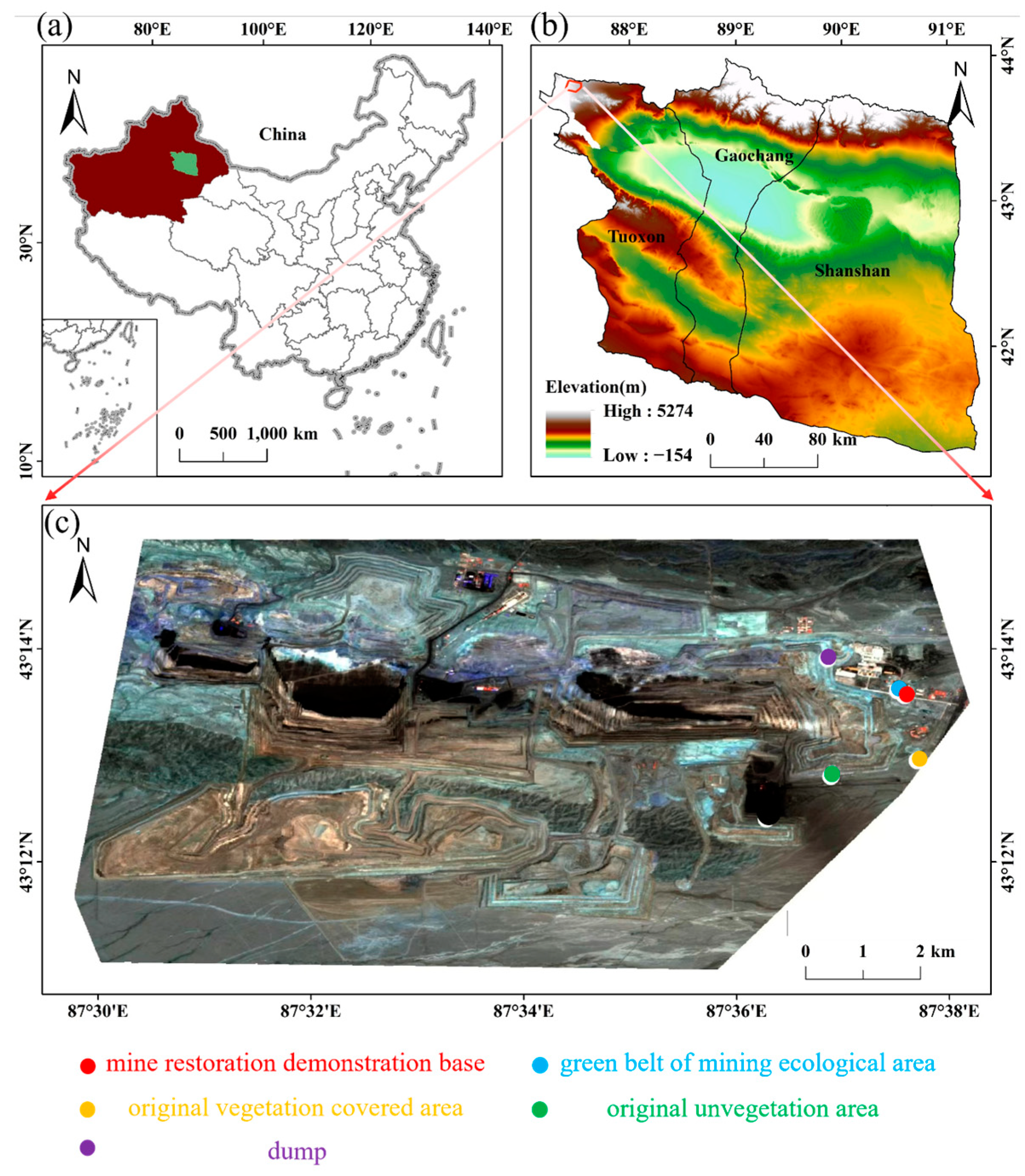

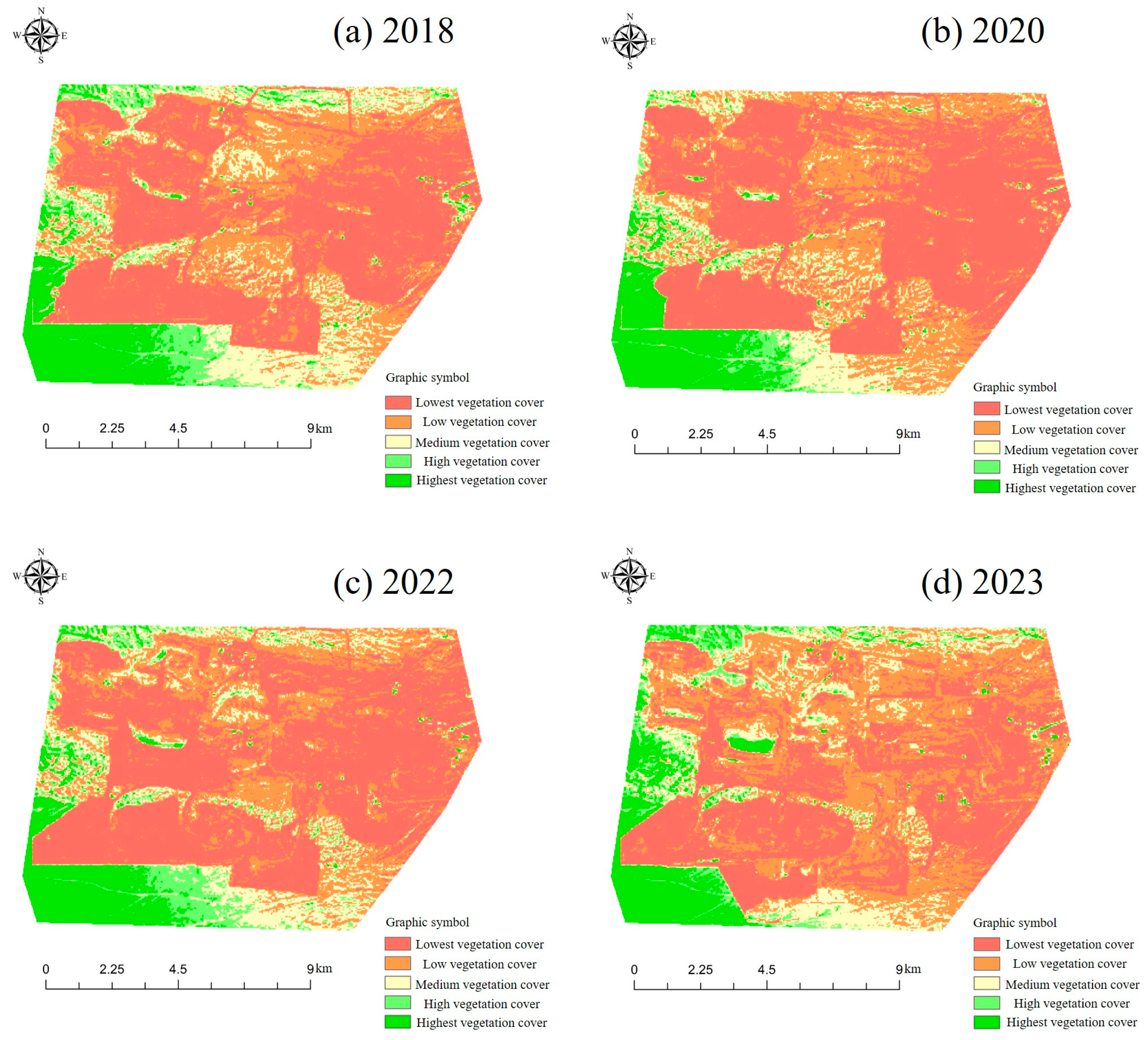

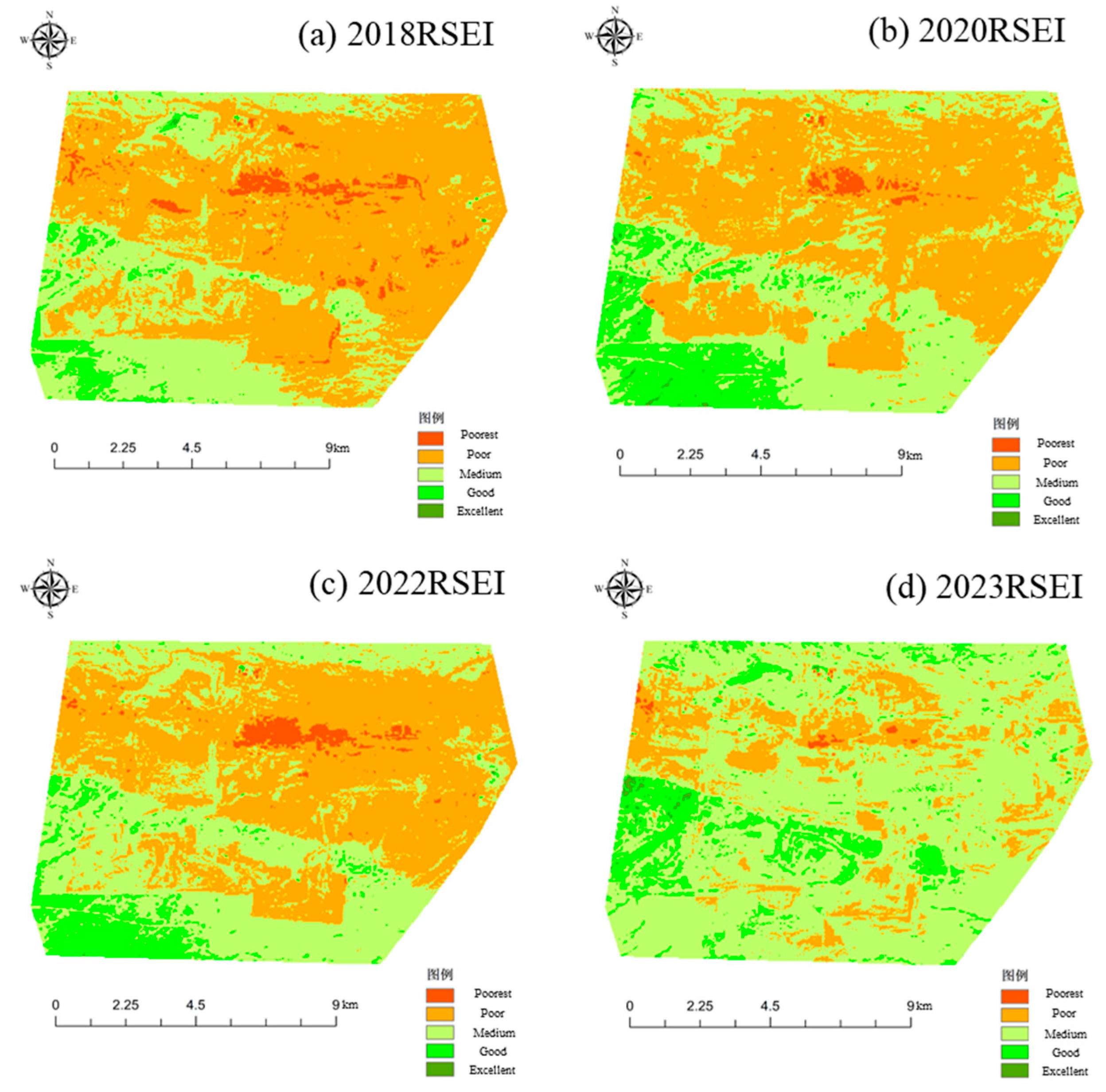

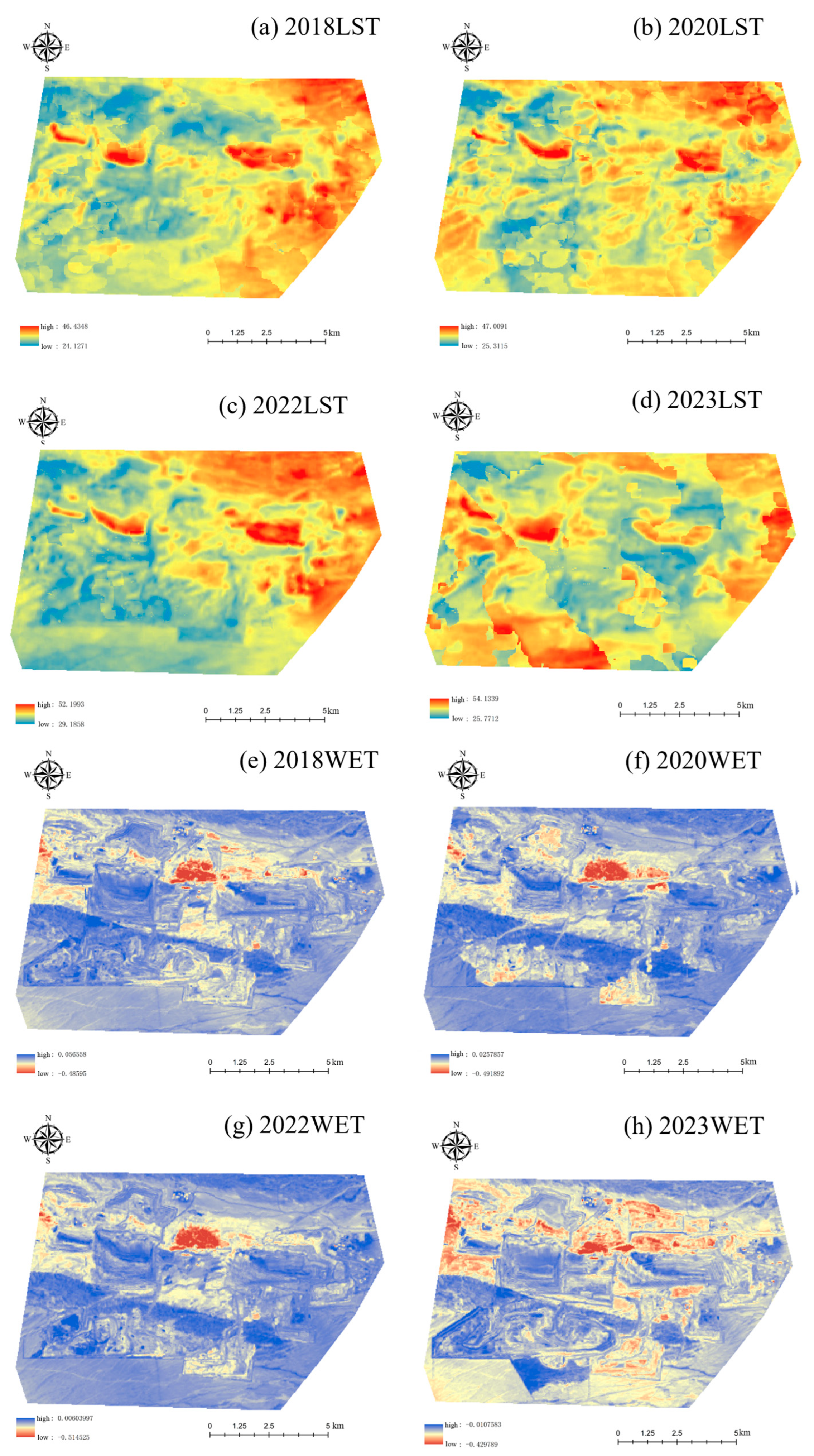
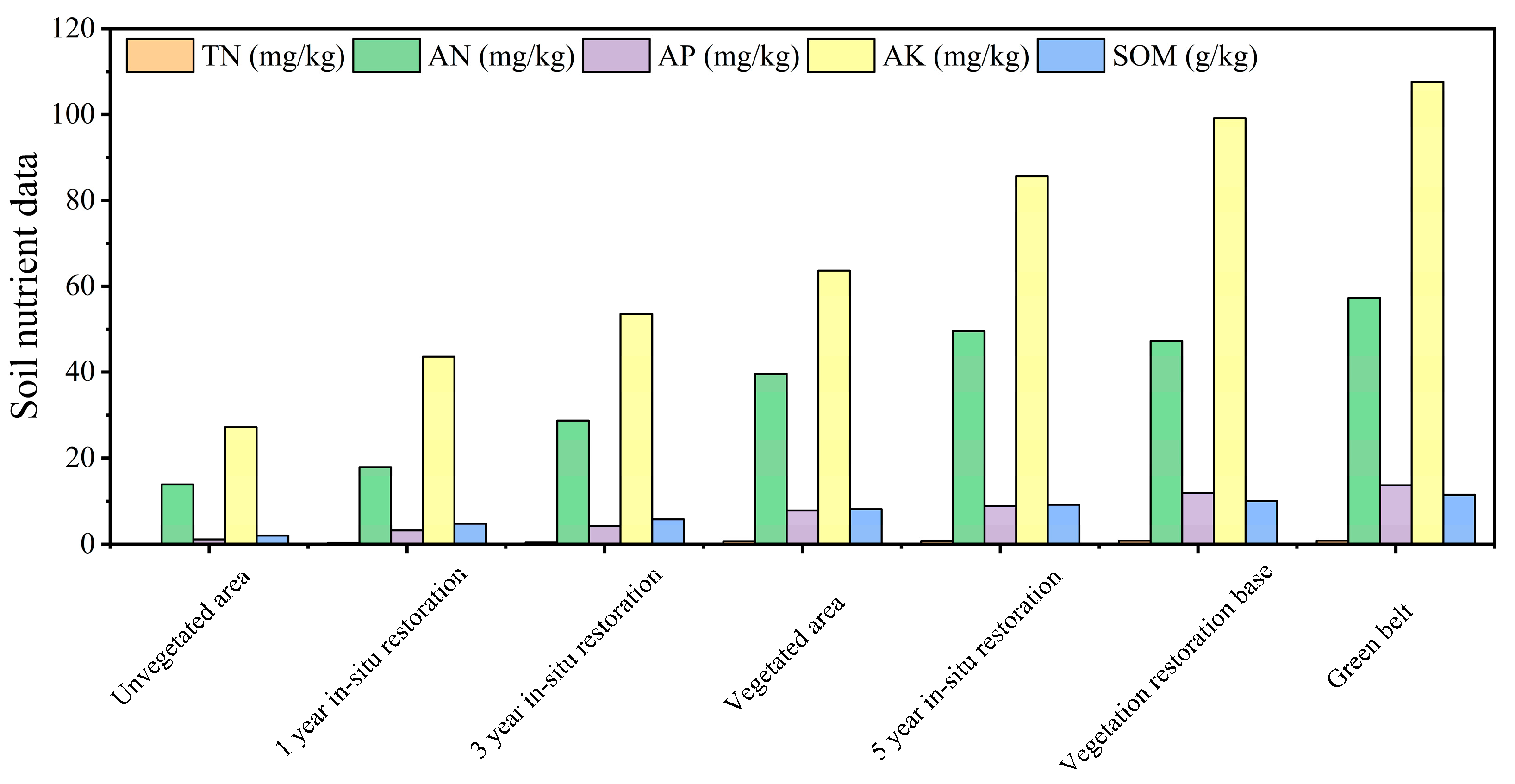
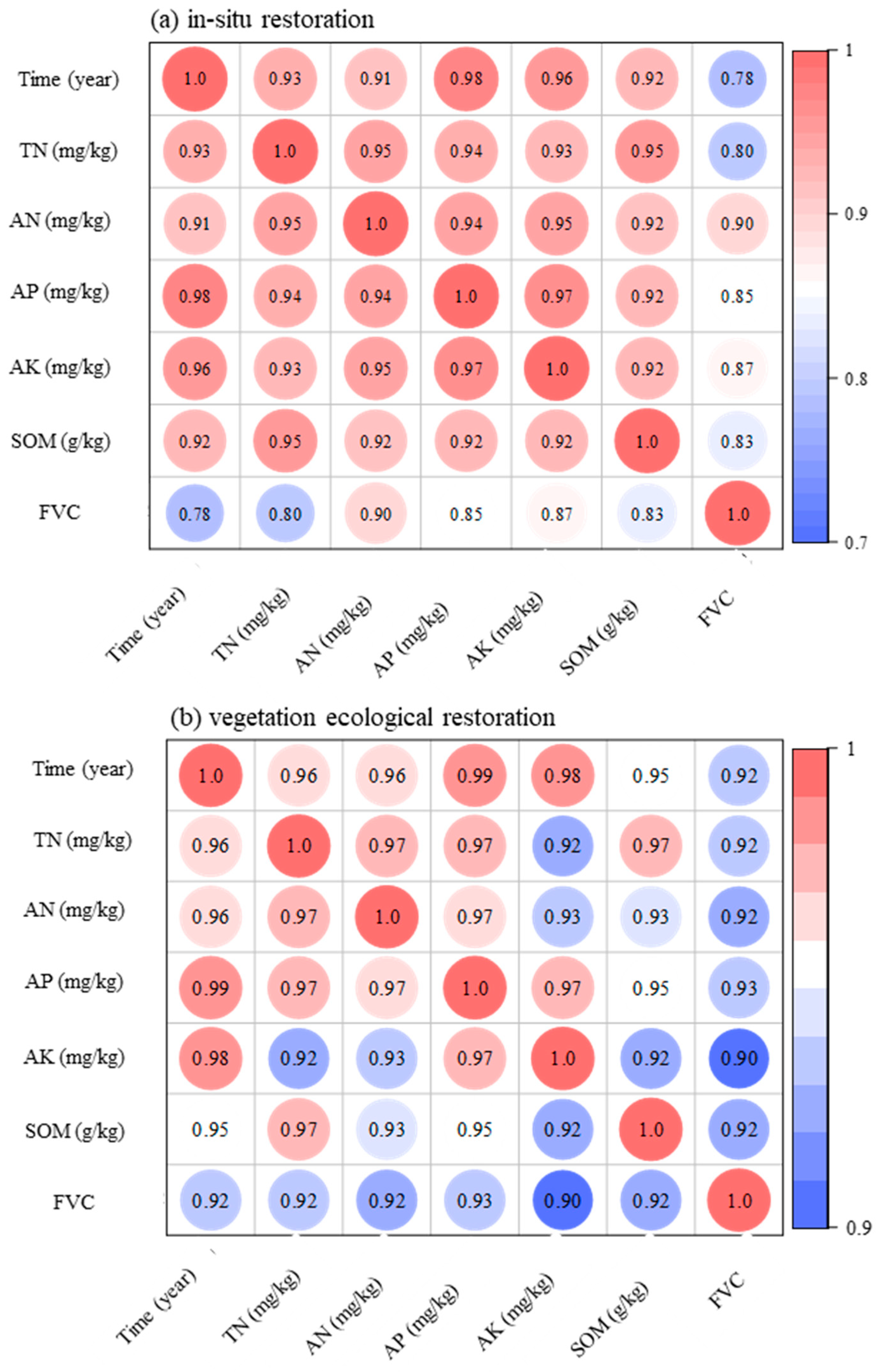
Disclaimer/Publisher’s Note: The statements, opinions and data contained in all publications are solely those of the individual author(s) and contributor(s) and not of MDPI and/or the editor(s). MDPI and/or the editor(s) disclaim responsibility for any injury to people or property resulting from any ideas, methods, instructions or products referred to in the content. |
© 2024 by the authors. Licensee MDPI, Basel, Switzerland. This article is an open access article distributed under the terms and conditions of the Creative Commons Attribution (CC BY) license (https://creativecommons.org/licenses/by/4.0/).
Share and Cite
Wu, Z.; Zhu, W.; Guo, H.; Zhang, Y.; Shen, C.; Guo, J.; Liu, M.; Zhao, T.; Teng, H.; Zhu, W.; et al. Effects of Soil Nutrient Restoration Aging and Vegetation Recovery in Open Dumps of Cold and Arid Regions in Xinjiang, China. Land 2024, 13, 1690. https://doi.org/10.3390/land13101690
Wu Z, Zhu W, Guo H, Zhang Y, Shen C, Guo J, Liu M, Zhao T, Teng H, Zhu W, et al. Effects of Soil Nutrient Restoration Aging and Vegetation Recovery in Open Dumps of Cold and Arid Regions in Xinjiang, China. Land. 2024; 13(10):1690. https://doi.org/10.3390/land13101690
Chicago/Turabian StyleWu, Zhongming, Weidong Zhu, Haijun Guo, Yong Zhang, Chaoji Shen, Jing Guo, Ming Liu, Tuanwei Zhao, Hu Teng, Wanli Zhu, and et al. 2024. "Effects of Soil Nutrient Restoration Aging and Vegetation Recovery in Open Dumps of Cold and Arid Regions in Xinjiang, China" Land 13, no. 10: 1690. https://doi.org/10.3390/land13101690
APA StyleWu, Z., Zhu, W., Guo, H., Zhang, Y., Shen, C., Guo, J., Liu, M., Zhao, T., Teng, H., Zhu, W., Kang, Y., Li, G., & Guan, W. (2024). Effects of Soil Nutrient Restoration Aging and Vegetation Recovery in Open Dumps of Cold and Arid Regions in Xinjiang, China. Land, 13(10), 1690. https://doi.org/10.3390/land13101690





